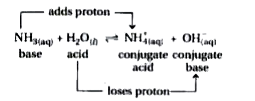Write the Bronsted - Lowry principle for acids and bases.
The Danish chemist, Johannes Bronsted and the English chemist, Thomas M. Lowry gave a more general definition of acids and bases.
Defination "According to Bronsted-Lowry theory, acid is a substance that is capable of donating a hydrogen ion (H+) and bases are substances capable of accepting a hydrogen ion, (H+)." In short, acids are proton donors and bases are proton acceptors.
e.g.-1 : Consider the example of dissolution of NH3 in H2O represented by the following equation.

The basic solution is formed due to the presence of hydroxyl ions. In this reaction, water molecule acts as proton donor and ammonia molecule acts as proton acceptor and are thus, called Lowry-Bronsted acid-base, respectively.
In the reverse reaction, H+ is transferred from NH+4 to OH−. In this case, NH+4 acts as a Bronsted acid while OH− acted as a Bronsted base.
Topper's Solved these Questions
- EQUILIBRIUMBOOK - KUMAR PRAKASHANCHAPTER - EQUILIBRIUMEXERCISE - SECTION-A Try Your self -2
6 Videos
- EQUILIBRIUMBOOK - KUMAR PRAKASHANCHAPTER - EQUILIBRIUMEXERCISE - SECTION-A Try Your self -3
10 Videos
- ENVIRONMENT CHEMISTRY BOOK - KUMAR PRAKASHANCHAPTER - ENVIRONMENT CHEMISTRY EXERCISE - Question For Module (Section-C)
1 Videos
- HYDROCARBONSBOOK - KUMAR PRAKASHANCHAPTER - HYDROCARBONSEXERCISE - (Questions for Module (Section - D))
1 Videos
Similar Questions
According to Bronsted - Lowry concept of acids and bases a conjugate acid - base paie can exist as

Mark the option in which conjugate pair is not correctly matched.
View SolutionAccording to Bronsted - Lowry concept of acids and bases a conjugate acid - base paie can exist as

Mark the option in which conjugate pair is not correctly matched.
View Solution
Knowledge Check
According to Bronsted-Lowry concept, base is a substance which is
AA proton donorBAn electron pair acceptorCA proton acceptorDAn electron pair donor
Discuss Lowry-Bronsted and Lewis concept of acids and bases.
View SolutionBronsted Lowry Acids And Bases
View SolutionAccording the Bronsted and Lowry , an acid is a……………….. A base is ………………..
View SolutionWrite four species which act both as Bronsted acid as well as base. Write their corresponding conjugate acids and bases.
View SolutionCommon upon H2O as an Arrhenius acid/base ,Bronsted-Lowry acid/base and Lewis acid /base.
View SolutionComment upon H2O as an Arrhenius acid/base ,Bronsted-Lowry acid/base and Lewis acid /base.
View SolutionA substance which can act both as an acid and a base is called………..
View Solution
